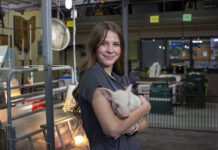COLUMBUS — Livestock producers should assess their beef production enterprises for areas that may need improvement to help ensure they’re able to benefit from the year’s high cattle prices for as long as possible, says a beef cattle expert with Ohio State University’s College of Food, Agricultural, and Environmental Sciences.
Good now, but…
Lower corn prices, improved pasture conditions, smaller beef cow herds and increased domestic demand combined to help beef cattle producers experience record prices for beef this year, said John Grimes, beef coordinator for Ohio State University Extension.
“But, no one knows how long these historically high prices will last,” Grimes said. “So producers should do what they can do now to make sure that they can take full advantage of the current situation and to make improvements that can carry them forward for years to come.”
Fewer cattle
The U.S. beef cow herd is at its smallest rate in decades, currently under 30 million cows, which is an 11.8 percent decline from 2007, he said.
Add to the equation that exports are increasing in volume and value, and beef’s largest competitors — pork and poultry — are in tighter supply, and beef producers are seeing prices that they’ve never seen before, Grimes said.
“For most beef cattle producers, it’s been like a honeymoon this year with such great prices, but that doesn’t mean that we should let our guards down on basic best livestock management practices,” he said.
“We have to make sure we keep our beef cattle bred, birth live calves and get them weaned, because we can’t sell them if we don’t have them.”
He offers these reminders for producers:
- Use proven management practices that can help you to improve conception rates, minimize calving difficulties, and increase the percentage of calf crop weaned.
- Cull open or any other unproductive animals with issues relating to disposition, udders structure and performance and replace them with younger, bred females.
- Evaluate the genetics in your herd to determine if they are allowing you to meet your production goals.
- Utilize the breeds and genetics within a breed that will help you achieve your goals.
- Are there management practices not being implemented in your operation because of a lack of equipment or facilities? Improving facilities can improve the quality of life for animals and simplify daily chores for the producer.
- Forages are the single most important feedstuff consumed by beef cattle. Increase forage quality and quantity produced from pasture and hay fields in order to maximize the pounds of beef produced per acre in your operation.
- Minimize feeding and storage losses associated with this valuable product.
“It takes at least 24 to 27 months from conception to consumption, so it’s a slow process to expand a herd,” Grimes said.
“The effects of your management decisions can be felt for a long time, so we’ve got to do it right.
“It’s easy to compensate for mistakes when prices are high, so we want to make sure that producers are ready if things change.”










